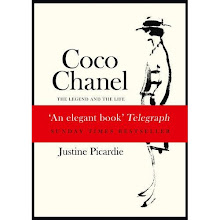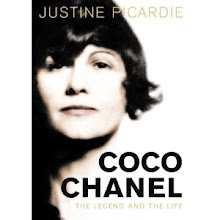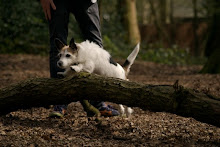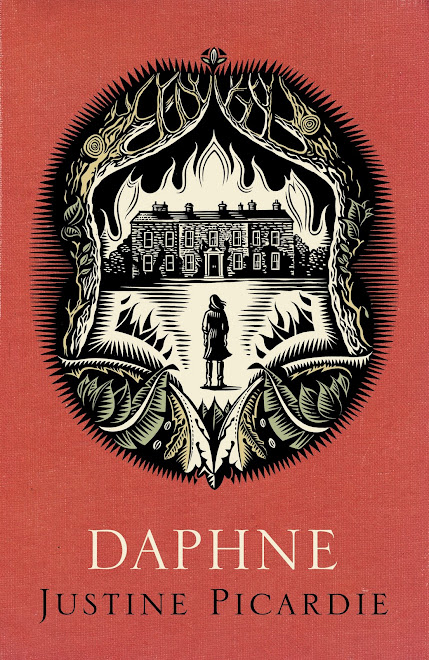I've just been for a midnight walk along the snowy streets, where everything is silent beneath the covering of white. There's no sound of cars -- the roads are too icy for drivers to get out -- and London is quieter than I've ever heard it. There is still a distant humming from faraway (of I know not what; but the city is never entirely still).
And as I was walking, I thought of the year that led up to this quiet moment. It began amidst the turmoil of great grief (for me, at least; although all the clamour of my sorrow is so small in this huge world), and is now coming to a close in a more peaceful way. If I have learnt one thing in the turning of the year, it is that however much one might want to be dull the pain of loss, it cannot be evaded; and yet unexpected joys can still appear out of nowhere, and a sense of blessing descends, even when you feared that the sky was falling down.
On Friday, I went to the funeral of a mentor, Paul Eddy, who I was fortunate enough to work for as a young journalist at the Sunday Times. The tributes were eloquent and moving, as were the words of the vicar, who said something very simple yet resonant: which is that at the end of a life, the most important thing is to know what it is to love, and to be loved.
He also quoted from a poet named John O'Donohue, an Irish writer, Celtic scholar and philosopher, who I hadn't come across before; and as is often the case, I then caught a few lines from the same poet on the radio a couple of days later (coincidence, or a chiming of the universe, or a blend of the two; the most potent magic of all).
So here is a poem by John O'Donohue; the Gaelic title is 'Beannacht'
Blessing
On the day when
the weight deadens
on your shoulders
and you stumble,
may the clay dance
to balance you.
And when your eyes
freeze behind
the grey window
and the ghost of loss
gets in to you,
may a flock of colours,
indigo, red, green,
and azure blue
come to awaken in you
a meadow of delight.
When the canvas frays
in the currach of thought
and a stain of ocean
blackens beneath you,
may there come across the waters
a path of yellow moonlight
to bring you safely home.
May the nourishment of the earth be yours,
may the clarity of light be yours,
may the fluency of the ocean be yours,
may the protection of the ancestors be yours.
And so may a slow
wind work these words
of love around you,
an invisible cloak
to mind your life.
Monday 21 December 2009
Thursday 10 December 2009
Advent Calendar


Last night I went to the Breast Cancer Care carol service at St Paul's cathedral, which was beautifully Christmas-y; and it felt like such a great privilege to sit within that inspiring church. As a Londoner, it's easy to take the city's grandest architecture for granted (head down, rushing through the streets, rarely looking up to the skyline) but whenever I emerge out of the fuggy darkness of the underground station at St Paul's, to be confronted by the graceful outline of the cathedral, I always feel glad to be alive.
I've been involved with the charity since 1998, after my sister died of breast cancer (I co-founded the Lavender Trust that year, which provides Breast Cancer Care's services for younger women); the carol service is one of many fundraising events through the year, and perhaps the loveliest. The cathedral choir sang like angels, and there were some wonderful readings, including this poem by Rowan Williams, read by Jeremy Irons. I hadn't come across it before, but thought it worth sharing with you.
Advent Calendar
He will come like last leaf's fall.
One night when the November wind
has flayed the trees to bone, and earth
wakes choking on the mould,
the soft shroud's folding.
He will come like frost.
One morning when the shrinking earth
opens on mist, to find itself
arrested in the net
of alien, sword-set beauty.
He will come like dark.
One evening when the bursting red
December sun draws up the sheet
and penny-masks its eye to yield
the star-snowed fields of sky.
He will come, will come,
will come like crying in the night,
like blood, like breaking,
as the earth writhes to toss him free.
He will come like child.
· From The Poems of Rowan Williams, published by Perpetua Press
Sunday 6 December 2009
Shanghai Uncut

Here's the piece I wrote about Chanel in Shanghai in today's Sunday Telegraph newspaper. It was very deftly edited to fit the page, but I thought I'd also post the uncut version, in case anyone wants a bit more detail on history etc. There's also a good review of the show on style.com by Sarah Mower, an interesting writer who is always worth reading.
Front row at the Chanel’s first fashion show in Shanghai, and the view is very different to the usual one of poker-faced editors in dark shades on the other side of the catwalk. Tonight, the entire audience is facing in the same direction, perched in a giant glass box on top of a barge moored on the edge of the Huangpu River, overlooking the extraordinary skyline of high-rises across the water in the booming financial district of Pudong. The night sky is alight with neon – translucent, surreal, glittering in a way that Karl Lagerfeld described earlier this afternoon as ‘magical, with colours that look somehow different to Europe, and a kind of transparency about them’. Tallest of all is the Shanghai World Financial Centre, 100 gleaming glass storeys outlined in turquoise blue lights, its top floors occupied by the Park Hyatt, the highest hotel in the world. Alongside is the giant HSBC tower and the Aurora skyscraper, where ‘Chanel’ is flashing in black and white lights up its vertiginous walls; and other towers loom like 21st century pastiches of Gotham City, with edges jagged as cartoon monster robots, or intersected with giant pink pearls.
In the dark waters of the river below, half a dozen police boats keep watch over the Chanel extravaganza, guarding the government officials inside the glass box who have been invited to see the show, along with the international fashion press and Chinese clients. Thus the official representatives of the People’s Republic of China sit side by side with Shanghai billionaires, while Vanessa Paradis (the new face of Chanel’s Coco Rouge advertising campaign) chats to Carine Roitfeld, editor of French Vogue. The proceedings kick off with a short film directed by Karl Lagerfeld, entitled ‘Paris Shanghai: a fantasy’, in which he imagines Coco Chanel travelling to the city in her dreams, and swapping her own couture jacket for a Chairman Mao jacket in the 1960s. The Chinese audience laughs, apparently amused by the idea; as they are by the scenes in the film that depict Chanel in the gambling dens and nightclubs of Shanghai in the 1920s and 30s, accompanied by the Duchess of Windsor and Marlene Dietrich. Thus the cultural references for the collection that follows are clearly delineated: little red dresses and little red bags (Chanel’s take on Mao’s Little Red Book); black transparent chiffon frocks glittering with red sequins (ready-to-wear for cocktails aboard the Shanghai Express); reinvented Chanel tweed jackets and suits in jade-green or Chinese red, accessorized with thigh-high boots, shiny as Oriental lacquer; white camellias and gold embroidery, reflecting the intricate designs on the 18th century Oriental Coromandel screens that Chanel collected, and which lined the walls of her Paris apartment and her suite at the Ritz.
After the show, phalanxes of policemen stop the traffic on the street outside the Peninsula hotel, as the audience stream into the Chanel party in the ballroom. Some of the government officials depart in sleek black limousines, guarded by dark-suited security men, but several hundred of the guests go straight from the catwalk to the Peninsula, along marble-floored corridors decorated with thousands of gilt Christmas baubles, past the brand-new Chanel boutique and its window display of handbags in bright pink, dragon red and emerald green.
This afternoon, even before the show began, the boutique was already doing booming business. It’s not the first in China – Chanel opened up in Beijing ten years ago – but it’s the biggest, selling to the fastest growing market in the world (currently galloping ahead at 20 per cent a year, with sales of luxury goods predicted to reach $12 billion in China by 2010, pushing Japan into second place in global consumption).
Less than 48 hours after opening, the Chanel boutique had sold out of the limited edition red handbags that Lagerfeld had created especially for Shanghai, and customers were adding their names to a lengthening waiting list. The price was 28,800 yuan – about £3000 – in a city where the average monthly wage is 2,000 yuan; but money seems to be no object to the girls who flit around the boutique, trying on shoes and jewellery with the practised alacrity of Carrie Bradshaw in Sex and the City. Glossy haired and immaculately manicured, they flash top of the range mobile phones and diamond rings; and most of them are already carrying Chanel handbags from recent collections, while their mothers wear Chanel tweed jackets, and smile indulgently, enthroned on Louis XV armchairs.
If the Chanel opening in Shanghai seems emblematic of a new era in global consumerism – the most iconic of luxury brands expanding into the People’s Republic of China – there are precedents in the recent past, as well as in previous decades, when Shanghai was christened the ‘Paris of the East’. Lanvin and Valentino opened boutiques in one of the city’s glitziest shopping malls last month, while Prada and Armani will soon be moving into the Peninsula alongside Chanel. Louis Vuitton has also made its presence felt in the city this week, presenting ‘Hair Room Service’ at the Park Hyatt by John Nollett, a famous French hairstylist who works with Uma Thurman and Diane Kruger, amongst others, and styled Vanessa Paradis’s hair for the Chanel party, where she performed a sultry 1930s nightclub act. Meanwhile, the fashion designer John Galliano checked into the Park Hyatt in Shanghai a few days ago, overseeing David Lynch’s new ad campaign for Dior, which is being shot at different locations in the city.
You can see why a filmmaker like Lynch would be as drawn to Shanghai as a designer steeped in the history of fashionable Orientalism. For as Lagerfeld commented before the Chanel show, the city is as much an idea as a reality for the West, ‘a mysterious place that is a great inspiration, with its intriguing mix between the contemporary and past Shanghai.’ Lagerfeld’s film suggested as much, with its hints of the Duchess of Windsor’s notorious past in Shanghai (rumour has it that she honed her sexual expertise here in the 1920s), and its references to Marlene Dietrich’s 1930s movies set in the city (‘Shanghai Express’ and ‘The House of Seven Sinners’, co-starring John Wayne).
But as Lagerfeld also observed, much of old Shanghai has disappeared, except in the imagination of romantic Westerners. True, he gave a dinner on the evening before his show at the Yongfoo Elite Club in the French quarter of the city, a former consulate decorated with authentic 1920s furnishings. Outside, the streets are still lined with plane trees planted by the European colonials, and a maze of traditional Chinese lanes is hidden behind the Art Deco facades, testament to the co-existing worlds that have existed in Shanghai since the end of the first Opium War in 1842. After the British attacked and invaded the city, they demanded that it become an open trading port, with a colonial settlement within Shanghai that was run entirely under British law; similar treaties were enforced by the French and Americans in 1844. Thus a westernised city evolved, but local poverty was far from eradicated. J.G Ballard, who was born to English parents in Shanghai in 1930, described its pre-war days as ‘90% Chinese and 100% Americanised’, with an international colony of about 50,000 people. ‘It was celebrated as the wickedest city in the world, though as a child I knew nothing about the thousands of bars and brothels. Unlimited venture capitalism rode in gaudy style down streets lined with beggars showing off their sores and wounds. Every day the trucks of the Shanghai municipal council roamed the streets collecting the hundreds of bodies of destitute Chinese who had starved to death. Partying, cholera and smallpox somehow coexisted with a small English boy's excited trips in the family Buick to the countryclub swimming pool.' He witnessed 'young Chinese gangsters in American suits; beggars fighting over their pitches; a vast firework displayed celebrating a new night-club while armoured cars of the Shanghai police drove into a screaming mob of rioting factory workers.' Open sewers flowed into the river and the whole city 'reeked of dirt, disease and a miasma of cooking fat from thousands of Chinese food vendors. Anyway was possible and everything could be bought and sold.'
After the Japanese invasion of the Second World War, Ballard was interned in a camp in Shanghai with his parents, witnessing some of the horrors of those years. When the Communists took over in 1949, they deemed Shanghai to be decadent, and its trading activities became dormant, the majestic mansions and banks requisitioned. Closed to the West, and decaying, it did not emerge until well after the modernizing reforms of Deng Xiao Ping. But the city has been growing at a dizzying pace since the early 90s, its air filled with the dust of demolition and construction; the grey clay churned over and over in the building of new six-lane motorways and monumental bridges; shanties bull-dozed for hundreds of new sky-scrapers and the 2010 World Expo, a vast international exhibition site taking shape alongside the Huangpu river.
Shanghai is as famous now for its pollution as its rampant economic growth, and the streets are filled with traffic jams, crawling beneath giant hoardings for Mercedes Benz. Some murmur that the boom will go bust, that the skyscrapers will crack with subsidence. And yet you can still sense the same vast appetite that Aldous Huxley described in the 1920s. ‘Nothing more intensely living can be imagined,’ he wrote, feeling the city to be so ‘tenaciously alive’ that it would last for ‘a thousand years hence’.
Whatever the modern contradictions that are apparent in the city today – and there are many – it nevertheless continues living at a fast and furious pace; a throbbing hub of trading where Jimmy Choo’s new line for H&M’s flagship Shanghai store sold out in minutes last month, and was being hawked for twice the price on the pavement afterwards. The overwhelming sense is of a young consumer population, fast becoming fluent in the language of Western celebrity culture, as well as their own. They read Chinese editions of In Style, Cosmo, Elle and Vogue, and are adept in the A to Z of European fashion, from Armani to Zara; they watch American television shows and listen to Lady Gaga. ‘Madonna is over,’ says a Chinese journalist from In Style, when I ask her about the current celebrity stakes, ‘Gossip Girl and Twilight are really popular now.’
As for the affluent Chanel customers: they shimmied at the after-show party with the same enthusiasm as they had shopped at the new boutique. Two of the most glamorous girls there – one in a new-season black Chanel dress, another in the label’s signature pearl-trimmed jacket – chatted to me about their love of fashion. Both had grown up in eminent government families; both were now regulars in the pages of Chinese Vogue. The girl in the pearl jacket introduced herself as Bao Bao Wan, the granddaughter of Wan Li, formerly vice premier of the People’s Republic of China, later chairman of the National People’s Congress. She had studied photography at Sarah Lawrence College in the US and French literature in Paris, where she attended the Bals de Debutantes.
What would her grandfather make of the scene at the Chanel party, I asked her, as we watched Vanessa Paradis sing to a whooping audience in the cream-carpeted Penisula ballroom? “He’s very open-minded,’ said Bao Bao, with a charming smile. And then she sashayed off on her high-heeled gladiator stilettos, to dance the night away in the warm scented air of Chanel no. 5, but with a confidence entirely her own.
Friday 4 December 2009
Could someone post a comment?
I am possibly being a bit paranoid, but the blogosphere has gone very silent since I went to China. I just want to check that the blog is still working. There was a rogue comment on my Philip Larkin post, which I have now deleted; but I do know that he has been hacking into other sites (not Larkin, that is; the strange commenter).
Apparently the odd blog comment directed readers to a Chinese page with a scantily clad young lady. Larkin might well have approved, but I'm not so sure about it.
Apparently the odd blog comment directed readers to a Chinese page with a scantily clad young lady. Larkin might well have approved, but I'm not so sure about it.
Shanghai Express



I've been in Shanghai, trying fruitlessly to get onto my blog (which appeared to be barred to me in China, and is now mysteriously bereft of comments; surely some mistake?), while writing about last night's Chanel fashion show and the launch of its huge boutique in the city. Shanghai is the most astonishing place -- the skyline of neon high-rises, a jumble of new buildings growing up from the traditional streets -- where the rumble of construction goes on day and night. In my blurred state of jet-lag, the city looked like a cross between Metropolis and Mad Max, Blade Runner and the Fifth Element. My head is still spinning, and I'm feeling weirdly dizzy, as if I've been on a boat (well, I was on a giant barge for the fashion show, but it was moored and unmoving). And I haven't even begun to tell you about the little red dresses.
More tomorrow, but until then, a link to the Paris-Shanghai express ...
Subscribe to:
Posts (Atom)






